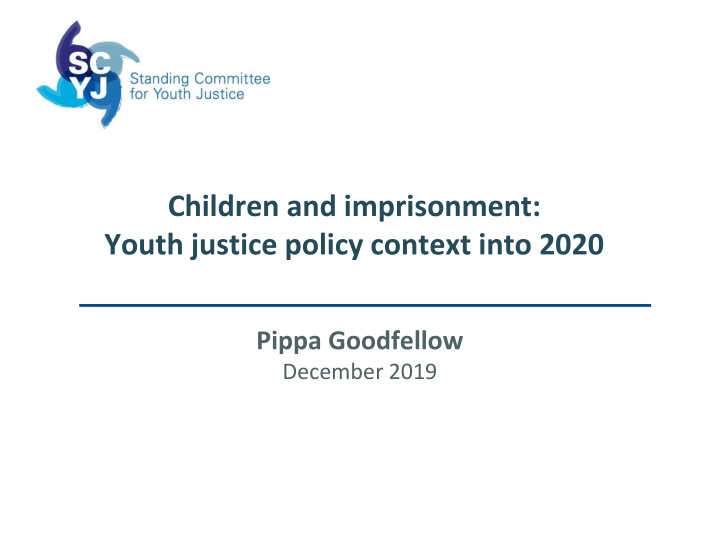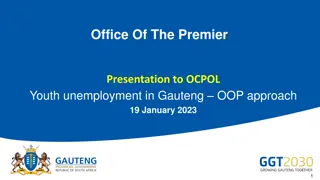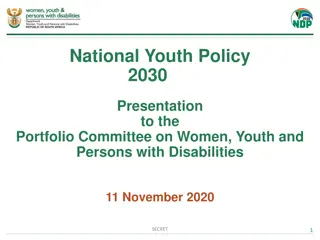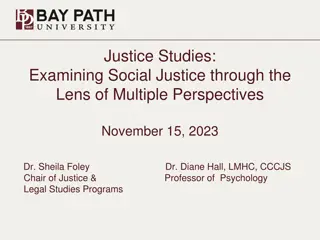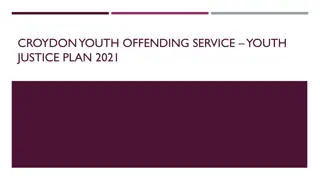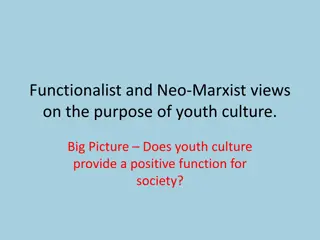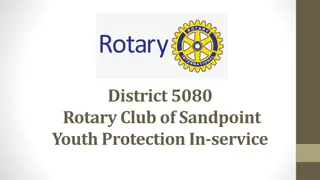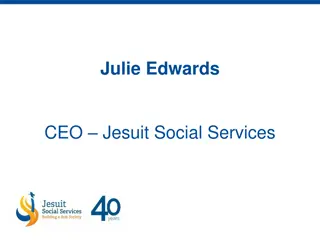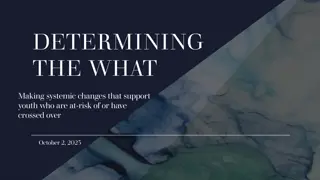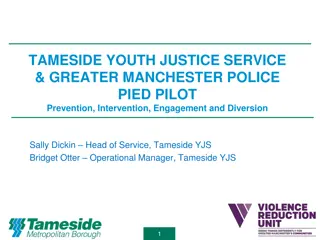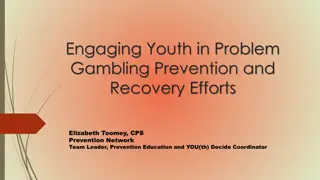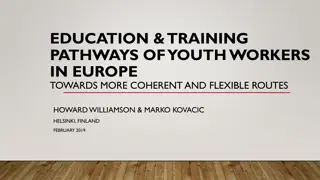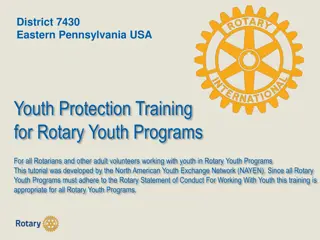Youth Justice Policy Trends and Changes since 2007
Recent trends in the youth justice system show a sharp decrease in the criminalisation and incarceration of children since 2007. This shift is attributed to increased diversion from the court system and a more tolerant approach towards youth crime. The focus is now on promoting positive outcomes and well-being for young people, advocating for responses that prioritize children's rights and emphasizing constructive approaches to youth justice.
Download Presentation

Please find below an Image/Link to download the presentation.
The content on the website is provided AS IS for your information and personal use only. It may not be sold, licensed, or shared on other websites without obtaining consent from the author.If you encounter any issues during the download, it is possible that the publisher has removed the file from their server.
You are allowed to download the files provided on this website for personal or commercial use, subject to the condition that they are used lawfully. All files are the property of their respective owners.
The content on the website is provided AS IS for your information and personal use only. It may not be sold, licensed, or shared on other websites without obtaining consent from the author.
E N D
Presentation Transcript
Children and imprisonment: Youth justice policy context into 2020 Pippa Goodfellow December 2019
Standing Committee for Youth Justice (SCYJ) An alliance of 60 non-profit organisations working to improve the youth justice system and in England and Wales. We pool the expertise of our members to address issues surrounding children in trouble with the law. Our work focuses on all aspects of the youth justice system and how to address issues affecting children in trouble with the law. We advocate a child-focused youth justice system that promotes the welfare and rights of children in trouble with the law, addresses the underlying causes of offending and promotes positive long-term outcomes.
Standing Committee for Youth Justice (SCYJ) Changing the narrative about why young people offend promoting widespread understanding about the underlying causes of offending behaviour and developing solutions collaboratively Advocating for responses that treat children as children first and foremost a distinct, child-focused system that upholds rights and promotes wellbeing Promoting a focus on constructive approaches and positive outcomes enabling young people to play to their strengths, move on and flourish Involving young people empowering young people to participate in decision-making about issues affecting their lives, valuing their perspective and expertise Reducing criminalisation and imprisonment of children promoting maximum diversion from the criminal justice system and opposing measures that are net- widening
Recent trends in the use of child custody The 1990s to mid-2000s was a period in which the criminalisation and incarceration of children grew significantly The period since 2007 has seen a sharp reversal of these trends Limited research (Allen, 2011; Bateman, 2012) has sought to explain the fall in the use of custody since 2007 Subtle convergence of a range of dynamics, rather than as a result of an intentional or explicit policy objective of central government Increased diversion from court critical to reducing throughput of children into custody, with more tolerant decisions being taken at courts in the context of a depoliticization of youth crime A non-punitive turn enabled these changes to unfold, as Allen (2011, p.25) concludes if the changes have not been directly stimulated by political leadership nor have they been impeded.
The recent policy context The Carlile Inquiry Report (2014) Lord Laming Review - reducing the criminalisation of looked after children (2016) Charlie Taylor s Review of the Youth Justice System (2017) Lammy Review - BAME individuals in the criminal justice system (2017) These reviews included recommendations for extensive changes to youth justice and the wider criminal justice system - on the face of it provide a rationale for significant and radical reform. Justice Select Committee Inquiry into children and young people in custody announced in 2019: SCYJ submission My submission about girls - -
The state of youth custody BBC Panorama programme aired in January 2015 - Medway STC Chief Inspector of Prisons concluded in 2017: there was not a single establishment that we inspected in England and Wales in which it was safe to hold children and young people dangerous, counter-productive and will inevitably end in tragedy unless urgent corrective action is taken Serious Case Review into Medway STC (2019) systemic failures in keeping children safe Youth Custody Improvement Board (2017) Independent Inquiry into Child Sexual Abuse - Sexual abuse of children in custodial institutions: 2009 2017 (2019) Urgent Notification Feltham YOI (2019) Youth Custody Safeguarding Review (2019) Medway STC inspection (2019) HMIP inspection into separation (forthcoming)
Custody as a last resort Custody must only be used as a last resort, for the shortest possible period of time, reserved for the most severe cases where it is required for public protection. The UN recommends that no child under the age of 16 should be sent to custody. The number and proportion of children in custody who are on remand is increasing, and almost two thirds of children on custodial remand go on to be acquitted or given a community sentence. Too many children are still being sentenced or remanded to custody. The reduction in numbers has been driven primarily through the reduction of white children.
Into 2020 What is the status of recommendations in various reports? Justice Select Committee Inquiry into youth custody opportunity to influence 3 years in February since the Youth Custody Improvement Board and Charlie Taylor s review Closure of Medway Secure Training Centre March 2020 Development of the first Secure School More punitive measures risk reversing progress in reducing levels of custody SCYJ will be working on: Ensuring custody is the last resort for children in England and Wales End Child Imprisonment Campaign BAME Overrepresentation in Youth Justice working party (Justice)
End Child Imprisonment Campaign Campaign run by a steering group of Article 39, the Centre for Crime and Justice Studies, Howard League for Penal Reform, INQUEST, Just for Kids Law, the NAYJ , the SCYJ and several leading children s rights and youth justice campaigners. The campaign aims to: Press for the closure of England s child prisons and raise awareness of the harms of child imprisonment. Propose a child welfare-based and human rights compliant secure model for the small number of children who cannot be safely looked after and supported in the community. Push for responsibility for detained children to be moved out of the government department that deals with adult imprisonment. At a local level, responsibility for the care and support of detained children must lie with children s social care services. Seek changes to law and practice so that deprivation of liberty is an absolute measure of last resort, leading to substantially fewer children being detained. Remove punishment and deterrence as reasons for locking up children. More information here: https://article39.org.uk/endchildimprisonment/
End Child Imprisonment Campaign For more information see: https://article39.org.uk/wp-content/uploads/2019/04/ECI- Principles-and-Minimum-Expectations-FINAL-pub-18-April-2019.pdf
Contact details and for more info My research report can be found here: Outnumbered, locked up and over-looked? The use of penal custody for girls in England and Wales Please feel free to contact me directly: pippa.goodfellow@scyj.org.uk @pgoodfellow_ For more information about the SCYJ: http://scyj.org.uk/ @thescyj
